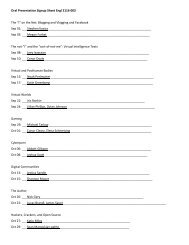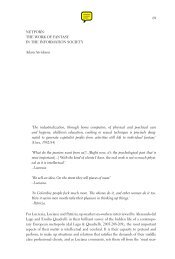Nakamura, Digitizing Race, Introduction, chapter 5, Epilogue
Nakamura, Digitizing Race, Introduction, chapter 5, Epilogue
Nakamura, Digitizing Race, Introduction, chapter 5, Epilogue
Create successful ePaper yourself
Turn your PDF publications into a flip-book with our unique Google optimized e-Paper software.
“Ramadan Is Almoast Here!” 39<br />
only Internet interaction’s relevance in the coming graphical age. Bolter<br />
and Grusin ask: “Can this digital, textual self maintain its claim to authenticity<br />
against the claims of the self expressed visually in virtual reality? The<br />
MUDs [multiuser domains] and chat rooms of the 1980s and early 1990s<br />
were exclusively textual and therefore remediated in the first instance the<br />
novel and the letter. Chat rooms may also remediate telephone conversations,<br />
but they suffer from the fact that the spoken voice on the telephone<br />
has a more obvious claim to immediacy than the typed word. As the transmission<br />
of video, animated graphics, and audio over the Internet is improving,<br />
these textual applications are threatened.” They conclude by citing the<br />
now-defunct Palace as an example of a “visual MUD” that “remediates the<br />
comic book” and mention that other “visual MUDs may remediate cinema<br />
and television more effectively, by offering animated figures or even video<br />
images of the participants themselves....In our visual culture today, it<br />
seems unlikely that any textual representation of the self can hold out long<br />
against the remediations of a rival, visual technology.” 3 One of the central<br />
claims of Remediation—that one of the most important yardsticks by which<br />
to evaluate digital technologies in relation to analog ones is on the basis of<br />
their enhanced immediacy—necessarily leads to the notion that online discourse<br />
supplemented by visual images is superior in terms of liveness or realness<br />
to the “typed word,” and thus graphical MUDs must be more appealing<br />
than textual MUDs because of their improved immediacy. They claim as<br />
well that televisual images made possible by broadband and applications<br />
like the Palace, which supported graphics in conjunction with textual interaction,<br />
would produce a hybrid form, less book than comic book or<br />
graphic novel, which would threaten the survival of text-only chat rooms<br />
and MUDs. Their discussion of the Palace dominates the <strong>chapter</strong> titled<br />
“The Virtual Self” because they believe that graphical MUDs are excellent<br />
examples of both immediacy and hypermediation not only because they<br />
embody both “live” and real-seeming interaction combined with overtly<br />
artificial or stylized uses of interfaces and visual conventions, but also because<br />
they enable identity swapping across the axis of gender, which is an<br />
essential feature of the type of postmodern self that the authors posit as the<br />
inevitable product of a networked culture. Per Persson concurs, speculating<br />
that cinema-desktop convergence will result in text-only MUDs being inevitably<br />
replaced by “‘rooms’ [that organize online conversations in terms of<br />
visual 3-D spaces] and environments like Palace, Active Worlds, or, in more<br />
sophisticated cases, VR teleconferencing systems.” 4





